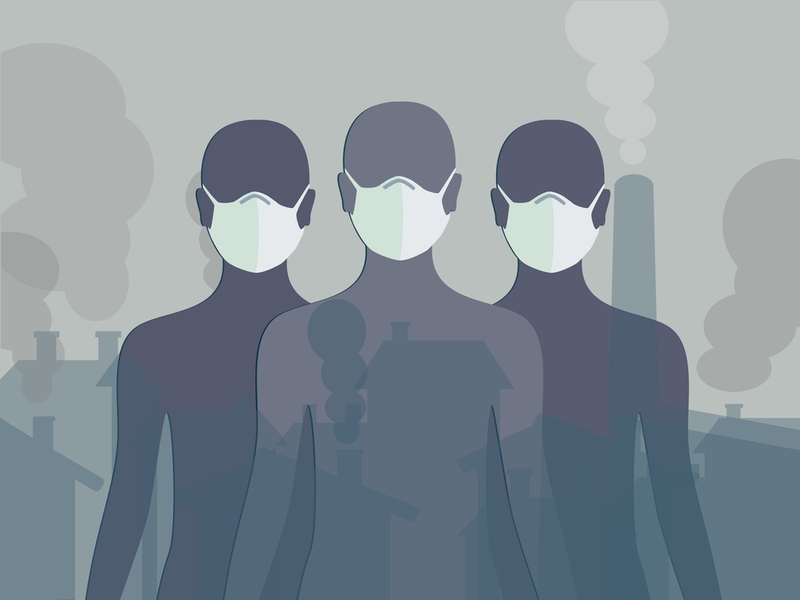Delhi has double concentration of dangerous pollutant PM1 that increases risk of lung cancer
IANS Apr 17, 2018
Delhi has almost twice the concentration of the more lethal pollutant PM1, or particles with diameter less than one micron, as compared to other cities where its being measured, data from government agency showed.

According to the data procured by System of Air Quality and Weather Forecasting And Research (SAFAR), in Delhi 47 percent of PM2.5 was composed of PM1 during winters, 44 percent during summers and 61 percent during monsoon, in 2017. Saying that though more study is required on the subject, Gufran Beig, Project Director SAFAR finds automobile combustion to be one of the major contributor of PM1 in Delhi.
PM1 concentration was also highest during November 2017 "smog-episode" in Delhi, during which its average concentration was around 130 units. However, SAFAR experts say that stubble burning may not be major contributor for PM1, as the burning events saw a peak in PM10 and PM2.5, but no change in PM1 concentration. "There must be other sources of PM1, beside automobile. Its a matter of investigation," Beig pointed out that there are at least 26 different sources of emission leading to air pollution in urban regions.
PM2.5 (or particles with diameter less than 2.5 micron) is the major pollutant in Delhi. Few studies had been done on PM1 globally and agencies are yet to mark safety standards for it. However, a recent study published by IIT-Delhi and IIT-Kanpur, finds that higher PM1 concentration on the roadside of Delhi increases risk of lung cancer. The study, "Chemical characterisation and quantitative assessment of source-specific health risk of trace elements in PM1 at a road site of Delhi, India", collected samples in Delhi from November 2009 to March 2010. The study found that during the period, 83 percent of PM2.5 was made up of PM1.
"The PM1 are mainly emitted from combustion sources," says the IIT study, pointing out that the increased number of private vehicles in the city increased from 3.3 million in 2000 to 7.4 million in 2013. The study also pointed out that chemical composition of the fine aerosol particles pose adverse effects on human health, especially in urban cities. According to several experts, PM1 might be the new enemy and focus may shift to the small particle soon.
As India expects implementation of the Bharat Standard-VI (Euro-VI equivalent) compliant cleaner transport fuels across the nation by April 2020, experts also warn that "finer the fuel, finer the emissions". SAFAR actively monitors PM1 in Delhi, Mumbai and Ahmedabad. According to its records, Delhi in 2017 saw an average concentration of PM1 at 79 units (PM2.5 169 units) in Winters, 33 units (PM2.5 75 units) in summers and 31 units (PM2.5 51 units) during monsoon. The units for particle pollutant is microgrammes per cubic meters.
Meanwhile, in the same period, the average concentration of PM1 in Mumbai was 38 units in winters (46 percent of PM2.5), 31 units in summers (46 percent of PM2.5) and 17 units during monsoon (50 percent of PM2.5). Ahmedabad in Gujarat, has the most moderate PM1 average concentration of all three cities, with 35 units in winters, 31 in summers and 16 during monsoon. According to Beig, drawing such results is important, as they provide the mitigation pathways to be adopted in different cities.
"Higher the PM1 share, more severe is the problem due to fossil fuel emissions," Beig said. According to the health experts, finer the particles, more deep they penetrate into the human lungs. Beig, who is member of the World Health Organisation (WHO) committee that fixes the health guidelines for hazardous pollutant, said that the issue has already been raised before the organisation. "In last meeting in 2016, we raised the issue of PM1. Committee decided that there are not enough hard evidences of its dangers, though we know it is hazardous," he added. The current international standards for PM2.5 is 60 units and for PM10 it is 100 units.
-
Exclusive Write-ups & Webinars by KOLs
-
Daily Quiz by specialty
-
Paid Market Research Surveys
-
Case discussions, News & Journals' summaries